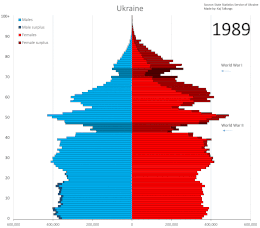

According to the United Nations, Ukraine has a population of 37.9 million as of 2024.[5]
In July 2023, Reuters reported that due to refugee outflows, the population of Ukrainian-controlled areas may have decreased to 28 million,[6] a steep decline from Ukraine's 2020 population of almost 42 million.[7][8] This drop is in large part due to the ongoing Ukrainian refugee crisis and loss of territory caused by Russia's invasion of Ukraine. The most recent (and only) census of post-Soviet Ukraine occurred in 2001, and much of the information presented is potentially inaccurate and/or outdated.
The majority of the historical information is sourced from Demoscope.ru.[9]
The territory of Ukraine has shifted greatly throughout history. Until 1939, Western Ukraine, west of the Zbruch River, had mostly been part of the Kingdom of Galicia and later the Polish Republic. Detailed information for those territories is missing (for more information, see Demographics of Poland). Crimea changed hands as well; in 1897 it was a part of the Taurida Governorate, but after the October Revolution became part of the Russian SFSR, and in 1954 was brought under the administration of the Ukrainian SSR. The territory of Budjak (southern Bessarabia) became a part of the Ukrainian SSR in June 1940.
There were roughly four million Ukrainians at the end of the 17th century.[10]
The censuses of 1926 through 1989 were conducted in the Ukrainian SSR. The 1897 census is drawn from the statistics of nine governorates located in present-day Ukraine. The 1906 records are taken from Statoids.com, which provides a broad degree of historical context on imperial Russia. The 1931 census statistics were estimated by Professor Zenon Kuzelia, [11] whose calculations are as of 1 January 1931. The Encyclopedia of Ukraine mentions Kuzelia as one of the only ethnographic sources available, due to the lack of an official census.[12][13]
[nb 1]
The Ukrainian famines of the 1930s, followed by the devastation of World War II, created a demographic disaster for the country. In 1933, life expectancy at birth fell to levels as low as ten years of age for females and seven for males, and plateaued around 25 for females and 15 for males between 1941 and 1944.[14] According to The Oxford companion to World War II, "Over 7 million inhabitants of Ukraine, more than one-sixth of the pre-war population, were killed during the Second World War."[15]
.jpg/440px-MALTESER_Ukrainehilfe_(51926526000).jpg)
Significant migration took place in the first years of Ukrainian independence. More than one million people moved into Ukraine in 1991–92, mostly from other former Soviet republics. Between 1991 and 2004, a total of 2.2 million immigrated to Ukraine (2 million of these from other former Soviet Union states), and 2.5 million emigrated from Ukraine (1.9 million of these to other former Soviet Union republics).[16] As of 2015, immigrants in Ukraine constituted an estimated 11.4% of the total population, or 4.8 million people.[17] In 2006, there were an estimated 1.2 million Canadians of Ukrainian ancestry,[18] giving Canada the world's third-largest Ukrainian population, behind Ukraine and Russia. Outside of these, there are also large Ukrainian diaspora communities in Poland, the United States, Brazil, Kazakhstan, and Argentina.
Since about 2015, a growing number of Ukrainians have worked in the European Union, particularly Poland. Eurostat reported that 662,000 Ukrainians received EU residence permits in 2017, 585,439 of them in Poland. In 2019, World Bank statistics showed that money remittances back to Ukraine roughly doubled from 2015 to 2018, and amounted to approximately 4% of Ukraine's GDP.[19][20] Ukraine only keeps records of its citizens who apply for foreign citizenship, not foreign residency[21]
With the Russian invasion of Ukraine, eight million people fled during the ensuing Ukrainian refugee crisis, Europe's biggest since World War II. Most have gone to Central Europe.

According to estimates by the State Statistics Service of Ukraine, the population of Ukraine (excluding Crimea) on 1 May 2021 was 41,442,615.[1]
The country's population has been declining since the 1990s because of a high emigration rate, coupled with high death rates and low birth rates. The population has been shrinking by an average of over 300,000 annually since 1993.
In 2007, the country's rate of population decline was the fourth highest in the world.[24]But between 2008 and 2010, over 1.5 million children were born in Ukraine, compared with fewer than 1.2 million in 1999–2001. In 2008, Ukraine posted record-breaking birth rates not seen since its 1991 independence. Infant mortality rates also dropped from 10.4 deaths to 8.3 per 1,000 children under one year of age, a lower rate than in 153 other countries.[25]
In 2019, the Ukrainian government conducted an electronic census using multiple sources, including mobile phone and pension data, and estimated that Ukraine's population, excluding Crimea and parts of the Donbas, to be 37.3 million. About 20 million were of active working age.[26][27]
The Russian invasion considerably deepened the country's demographic crisis due to the illegal annexation of multiple oblasts, numerous civilians fleeing the country, and high casualties. A July 2023 study by the Vienna Institute for International Economic Studies stated the following:
"Regardless of how long the war lasts and whether or not there is further military escalation, Ukraine is unlikely to recover demographically from the consequences of the war. Even in 2040 it will have only about 35 million inhabitants, around 20% fewer than before the war (2021: 42.8 million) and the decline in the working-age population is likely to be the most severe and far-reaching."
The study examined different scenarios, from a "best case", in which the war ended in 2023 without significant further escalation, to a "worst case", ending in 2025 after further escalation. Flight from war particularly affects the southern and eastern regions and especially educated women of child-bearing age and their children. With an estimate of more than 20% of refugees not returning, study author Maryna Tverdostup concludes that this will lead to long-term shrinking and will significantly impair the conditions for reconstruction.[28]
As of 2020, the birth rate in Ukraine was 8.1 live births/1,000 population, and the death rate 14.7 deaths/1,000 population.[4]
Lowest-low fertility, defined as total fertility below 1.3, is being encountered across Europe, attributed by many to postponement of the initiation of childbearing. Ukraine, where total fertility (1.1 in 2001), was one of the world's lowest, shows that there is more than one pathway to lowest-low fertility. Although Ukraine underwent immense political and economic transformations from 1991 to 2004, it maintained a young age at first birth and nearly universal childbearing. Analysis of official national statistics and the Ukrainian Reproductive Health Survey show that fertility declined to very low levels without a transition to a later pattern of childbearing. Findings from focus group interviews suggest that the early fertility pattern was explained by the persistence of traditional norms for childbearing and the roles of men and women, concerns about medical complications and infertility at a later age, and the link between early fertility and early marriage.[29] Ukraine subsequently has one of the oldest populations in the world, with an average age of 40.8 years.[30]
To help mitigate population decline, the government increased child support payments, providing one-time payments of 12,250 hryvnias for the first child, 25,000 hryvnias for the second and 50,000 hryvnias for the third and fourth, along with monthly payments of 154 hryvnias per child.[31][32] The demographic trend showed signs of improvement as the birth rate grew steadily from 2001 to 2013.[33] Five of the country's 24 provinces showed net population growth over the first nine months of 2007, and nationwide population decline showed signs of stabilization. In 2007, the highest birth rates were in the western oblasts.[34] In 2008, Ukraine emerged from lowest-low fertility, and the upward trend continued to 2012, with population decline slowing year after year. If early 2010s trends had persisted, the population could have returned to positive growth later that decade. Similar trends occurred in Russia and Belarus, which experienced population growth in the 2010's.
In 2014, the strong drop in births returned, and 2018 saw fewer than half the number of births of 1989 (see demographic tables). In 2020, the number of births decreased to 293,000, reaching rates not seen in a quarter century.
Mass emigration and property destruction caused by the Russian invasion led Ukraine's birth to drop still further: it was 28% lower in the first half of 2023 than the first half of 2021.[35] However, a small but meaningful increase in births may have occurred, with a potential fertility rate increase to 1.60 children per woman, higher than the 2012 peak of 1.53.[36]
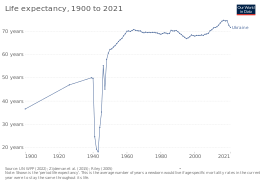

Average life expectancy at birth of the total population.[37]
Notable events in Ukrainian demographics:
The figures below refer to the nine governorates of the Russian Empire (Volhynia, Katerynoslav, Kyiv, Podilia, Poltava, Tauryda, Kharkiv, Kherson and Chernihiv) with a Ukrainian majority.[41]
(a) Information is given for Ukraine's territory within its old boundaries up to 17 September 1939 (b) Information is given for Ukraine's territory within its present-day boundaries, after the Soviet annexation of Eastern Galicia and Volhynia in September 1939
Source: State Statistics Service of Ukraine[43]
Note: Data excludes Crimea starting in 2014.[45]
[43]
Note: Russia occupied and later annexed the Crimean Peninsula in 2014. The annexation is internationally recognized only by a small number of nations. The Ukrainian statistics Service can no longer provide accurate data on Crimea in the post-2014 period. Therefore, starting from 2014, the territories of the Autonomous Republic of Crimea and the city of Sevastopol are not included in the Demographics of Ukraine, but instead are included to the Demographics of Russia. All data from State Statistics Service of Ukraine.

Note: Recent data for Donetsk and Luhansk Oblasts has been affected by the war in Donbas, and may only include births within the government-held parts of the oblasts.[47]
Compared to 2012, amount of attrition increased by 16,278 persons, or 3.1 to 3.5 persons per 1,000 inhabitants real. Natural decrease was observed in 23 oblasts of the country, while natural increases were recorded only in the capital Kyiv, Zakarpattya, Rivne and Volyn oblast (respectively 5,302, 3,689, 2,889 and 1,034 people).
Some regions registered a low natural decline, such as Chernivtsi, Ivano-Frankivsk, Sevastopol, Lviv, Ternopil, Crimea, Kherson and Odesa (respectively, −55, −642, −863, −2,124, −2,875, −2,974, −3,748 and −4,448 people). The largest declines were recorded in Donetsk, Luhansk, Dnipro, Kharkiv, Poltava and Chernihiv (respectively −28,311, −15,291, −15,007, −12,765, −10,062 and −10,057), regions which have in common a low birth rate and high mortality of a large urban population and a strong rural population aging.
-5.4 migrant(s)/1,000 population (2015).
Although none of the oblasts in 2013 has recorded a higher fertility rate 2.10 children per woman. However, the rate has been in rural areas in the Rivne Oblast (2.50) and the Volyn Oblast (2.20). While a very close generational renewal rate was achieved in the Odesa Oblast (2.04), Zakarpattia Oblast (2.00), Mykolaiv Oblast (1.95), Chernivtsi Oblast (1.93) and Zhytomyr Oblast (1.91) weaker when they have been recorded in the Luhansk oblast (1.41), Sumy oblast (1.47) and Cherkasy Oblast (1.53).
The fertility rate of the highest urban areas were recorded in the Zakarpattia Oblast (1.80), the city of Sevastopol (1.57), Volyn Oblast (1.56), Kyiv Oblast (1.56) and the Rivne Oblast (1.54). The lowest rates were recorded in the Sumy Oblast (1.23), Kharkiv Oblast (1.26), Cherkasy Oblast (1.28), Chernihiv Oblast (1.28), Chernivtsi Oblast (1.28), Luhansk oblast (1.28), Poltava oblast (1.29), Donetsk oblast (1.29) and Zaporizhzhia Oblast (1.32).

Demographic statistics according to the World Population Review in 2019.[49]
Demographic statistics according to the CIA World Factbook, unless otherwise indicated.[30]
Ukrainian 77.8%, Russian 17.3%, Belarusian 0.6%, Moldovan 0.5%, Crimean Tatar 0.5%, Bulgarian 0.4%, Hungarian 0.3%, Romanian 0.3%, Polish 0.3%, Jewish 0.2%, other 1.8% (2001 est.)
Ukrainian (official) 67.5%, Russian (regional language) 29.6%, other (includes small Crimean Tatar-, Moldovan/Romanian-, and Hungarian-speaking minorities) 2.9% (2001 est.)
Note: in February 2018, the Constitutional Court ruled that 2012 language legislation entitling a language spoken by at least 10% of an oblast's population to be given the status of "regional language" – allowing for its use in courts, schools, and other government institutions – was unconstitutional, thus making the law invalid; Ukrainian remains the country's only official nationwide language.
Orthodox (includes Ukrainian Autocephalous Orthodox (UAOC), Ukrainian Orthodox – Kyiv Patriarchate (UOC-KP), Ukrainian Orthodox – Moscow Patriarchate (UOC-MP)), Ukrainian Greek Catholic, Roman Catholic, Protestant, Muslim, Jewish
Note: Ukraine's population is overwhelmingly Christian; the vast majority – up to two-thirds – identify themselves as Orthodox, but many do not specify a particular branch; the UOC-KP and the UOC-MP each represent less than a quarter of the country's population, the Ukrainian Greek Catholic Church accounts for 8–10%, and the UAOC accounts for 1–2%; Muslim and Jewish adherents each compose less than 1% of the total population (2013 est.)
definition: age 15 and over can read and write (2015 est.)
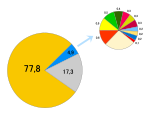
In 2001, the ethnic composition was: Ukrainians 77.8%, Russian 17.3%, Romanian 1.1% (including Moldovan 0.8%), Belarusian 0.6%, Crimean Tatar 0.5%, Bulgarian 0.4%, Hungarian 0.3%, Polish 0.3%, Jewish 1.0%, Pontic Greeks 0.2% and other 1.6% (including Muslim Bulgarians, otherwise known as Torbesh and a microcosm of Swedes of Gammalsvenskby).[50] It is also estimated that there are about 49,817 ethnic Koreans (0.12%) in Ukraine that belong to the Koryo-saram group. Their number may be as high as 100,000 as many ethnic Koreans were assimilated into the majority population.[51][52] Rusyns are also not recognised by the Ukrainian government as a distinct ethnic group and are instead treated as a sub-group of Ukrainians.[53]
According to the 2021 law “On the Indigenous Peoples of Ukraine” the Crimean Tatars, Crimean Karaites and Krymchaks are the indigenous peoples of Ukraine.[54]

Ethnic Groups in Ukraine 2001[60]
According to the 2001 census, the following languages are common in Ukraine: Ukrainian 67.5%, Russian 29.6%, Crimean Tatar, Urum (Turkic Greeks), Bulgarian, Moldovan/Romanian, Polish, Hungarian. The below table gives the total population of various ethnic groups in Ukraine and the primary language, according to the 2001 census.[50]
A 2018 survey conducted by the Razumkov Centre found that 71.7% of the population declared themselves believers in any religion, while 4.7% declared themselves non-believers, and 3.0% declared to be atheists.[61] Of the total Ukrainian population, 87.4% declared to be Christians, comprising a 67.3% who declared to be Eastern Orthodox, 10.2% Catholic (split into 9.4% Ukrainian Greek Catholics and 0.8% Latin Catholics), 7.7% "Christians", and 2.2% Protestants. Judaism comprises 0.4% of the population. In earlier surveys around 1-2% of the population stated that they adhere to Islam.
According to data from 2018 among those Ukrainians who declared to believe in Orthodoxy, 28.7% declared to be members of the Ukrainian Orthodox Church of the Kyivan Patriarchate (being incorporated as of the 5 January 2019 into the Orthodox Church of Ukraine), while 12.8% declared to be members of the Ukrainian Orthodox Church of the Moscovian Patriarchate (which is an autonomous Eastern Orthodox church under the Russian Orthodox Church). A further 0.3% were members of the Ukrainian Autocephalous Orthodox Church, which, like the Kyivan Patriarchate, where incorporated in 2019 into the Orthodox Church of Ukraine. Among the remaining Orthodox Ukrainians, 23.4% declared to be "simply Orthodox", without affiliation to any patriarchate, while a further 1.9% declared that they "did not know" which patriarchate or Orthodox church they belonged to.[61]
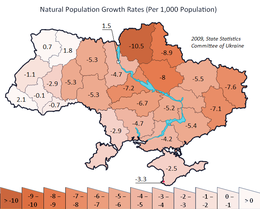
Between the Soviet census of 1989 and the Ukrainian census of 2001, Ukraine's population declined from 51,706,600 to 48,457,020,[62] a loss of 2,926,700 people or 5.7% of the 1989 population. However, this trend has been quite uneven and varied regionally. Two regions in western Ukraine — Rivne and Zakarpattia, saw slight population increases of 0.3% and 0.5% respectively. A third western Ukrainian region, Volyn, lost less than 0.1% of its population between 1989 and 2001.[62] Collectively, between 1989 and 2001 the seven westernmost regions of Ukraine lost 167,500 people or 1.7% of their 1989 population. The total population of these regions in 2001 was 9,593,800.[62]
Between 1989 and 2001, the population of Kyiv City increased by 0.3%[62] due to positive net-migration.[citation needed] Outside the capital, the central, southern and eastern regions experienced a severe decline in population. Between 1989 and 2001, the Donetsk region lost 491,300 people or 9.2% of its 1989 population, and neighbouring Luhansk region lost 11% of its population.[62] Chernihiv region, in central Ukraine northeast of Kyiv, lost 170,600 people or 12% of its 1989 population, the highest percentage loss in of any region in Ukraine. In southern Ukraine, Odesa region lost 173,600 people, or 6.6% of its 1989 population. By 2001, Crimea's population declined by 29,900 people, representing only 1.4% loss of the 1989 population.[62]
However, this was due to the influx of approximately 200,000 Crimean Tatars – a number equivalent to approximately 10% of Crimea's 1989 population – who arrived in Crimea after 1989 and whose population in that region increased by a factor of 6.4 from 38,000 to 243,400 between 1989 and 2001.[63] Collectively, the net population loss in the regions of Ukraine outside the westernmost regions was 2,759,200 people or 6.6% of the 1989 population. The total population of these regions in 2001 was 39,186,100.[62]
Thus, from 1989–2001 the pattern of population change was one of slight growth in Kyiv, slight declines in western Ukraine, large declines in eastern, central and southern Ukraine and a relatively small decline in Crimea due to a large influx of Crimean Tatars.
Ukraine's total fertility rate is one of the lowest in Europe.[64][65] However, significant regional differences in birth rates may account for some of the demographic differences. In the third quarter of 2007, for instance, the highest birth rate among Ukrainian regions occurred in Volyn Oblast, with a birth rate of 13.4/1,000 people, compared to the Ukrainian country-wide average of 9.6/1,000 people.[66] Volyn's birthrate is higher than the average birth rate of any European country with the exceptions of Iceland and Albania.[67]
In 2007, for the first time since 1990, five Ukrainian regions (Zakarpattia Oblast, Rivne Oblast, Volyn Oblast, Lviv Oblast, and Kyiv Oblast) experienced more births than deaths.[68] This demonstrates a positive trend of increasing birthrates in the last couple of years throughout Ukraine. The ratio of births to deaths in those regions in 2007 was 119%, 117%, 110%, 100.7%, and 108%, respectively.[68]
With the exception of Kyiv region, all of the regions with more births than deaths were in the less industrially developed regions of western Ukraine. According to a spokesperson for Ukraine's Ministry of Justice, the overall ratio of births to deaths in Ukraine had improved from 1 to 1.7 in 2004–2005 to 1 to 1.4 in 2008. However, the worst birth to death ratios in the country were in the eastern and central oblasts of Donetsk, Luhansk, Cherkasy and Poltava. In these regions, for every birth there were 2.1 deaths.[69]
Notably, western Ukraine never experienced the Holodomor, as Poland, Czechoslovakia, and Romania ruled it at the time, helping to explain the better demographics there, as the rural population was never devastated. Specifically, during the time of the Holodomor, Poland ruled Ivano-Frankivsk, Lviv, Rivne, Ternopil, and Volyn Oblasts, whereas Zakarpattia Oblast was under Czechoslovak rule, and Romania controlled Chernivtsi Oblast and the Budjak section of Odesa Oblast.
Abortion behavior in the North, South, East and Center regions of Ukraine are relatively homogeneous while the Western region differs greatly. Overall, the abortion rate in western Ukraine is three times lower than in other regions; however this is not due to an increased use of modern contraceptive methods in the West, but simply due to the fact that pregnant women in the Western regions are more likely to keep their babies.[70] Donetsk and Dniproptrovsk oblasts in eastern and central Ukraine have the country's highest rate of abortions.[71]

Death rates also vary widely by region; Eastern and southern Ukraine have the highest death rates in the country, and the life expectancy for children born in Chernihiv, Dnipropetrovsk, Donetsk, Kherson, Kropyvnytskyi, Luhansk, Mikolaiv, and Odesa regions is 1.5 years lower than the national average.[72]
Ukraine had a suicide rate of 16.5 per 100,000 population in 2017, a significant decrease from the suicide rate of 29.6 per 100,000 in 1998. Suicides are more frequent in the central part of the country (the highest suicide rates was in Kirovohrad Oblast; In western Ukraine, the suicide rate was lower than the national average. Lviv Oblast has the lowest suicide rate – 5.3[73]
The Southern and eastern Ukrainian regions also suffer from the highest rates of HIV and AIDS, which impacts life expectancy. In late 2000, 60% of all AIDS cases in Ukraine were concentrated in the Odesa, Dnipropetrovsk, and Donetsk regions.[74] A major reason for this is the fact that the urbanized and industrialized regions in the East and South of Ukraine suffered most from the economic crisis in the 1990s, which in turn led to the spread of unemployment, alcoholism, and drug abuse, thus setting the conditions for wider spread of the epidemic.[75]
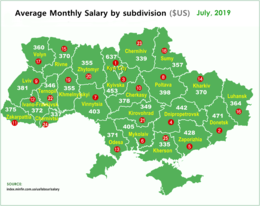
The western and central regions of Ukraine had lower GDP per capita than Kyiv and the industrialized eastern regions of Ukraine. In December 2019 the average monthly salary in Ukraine was 12,264 hryvnias (or 519 US dollars). Chernihiv oblast (northern Ukraine) and Kirovohrad Oblast (central Ukraine), had the lowest monthly salary of 8,851 and 9,450 hryvnias, respectively. In contrast, the monthly wage in the city of Kyiv was 18,869 hryvnias per month, and in Kyiv oblast – 13,259 per month.[76] In 2013, outside of the capital city of Kyiv, the wealthiest region was Donetsk Oblast with annual income 31,048 hryvnias. But as of 2017, Donetsk Oblast ranks as the second poorest after Luhansk Oblast with annual incomes 25,278 hryvnias and 16,416 hryvnias respectively.[77] Both are in the eastern Ukraine and have sustained direct losses as a consequence of military actions.
Ukraine recorded one of the sharpest declines in poverty of any transition economy in 2001–2016 years. The poverty rate, measured against an absolute poverty line (below $1.25 per day in dollars, based on World Bank) fell from a high of 32 percent in 2001 to 8 percent in 2005. In terms of poverty rates, the central and northern regions have the country's highest poverty rates – 10.0%. The western and southern regions – 9.1% and 9% respectively. Kyiv City had the lowest poverty rate – 1.4%.[78]Percent of population living under $5.50 a day was 19% in 2005 and dropped to 4.0 percent in 2018.[79][80]
Ukraine is the major source of migrants for many EU member states. In the 1990s and early 2000s, Ukraine's sputtering economy and political instability contributed to rising emigration, especially to nearby Poland and Hungary, but also to other countries like Italy, Portugal, Spain, Israel and Canada. Although estimates vary, approximately two to three million Ukrainian citizens are currently working abroad, in construction, service, housekeeping, and agriculture industries.
Between 1991 and 2004, the government counted 2,537,400 individuals who emigrated; 1,897,500 moved to other post-Soviet states, and 639,900 moved to other, mainly Western, states.[81]
By the early 2000s, Ukrainian embassies reported that 300,000 Ukrainian citizens were working in Poland, 200,000 in Italy, approximately 200,000 in the Czech Republic, 150,000 in Portugal, 100,000 in Spain, 35,000 in Turkey, 20,000 in the United States and smaller but significant numbers in Austria, Belgium, France, Germany, Greece, Sweden, Switzerland and the UK. The largest number of Ukrainian workers abroad, about one million, were in the Russian Federation. Since 1992, 232,072 persons born in Ukraine have emigrated to the US.
Yet absolute numbers are less relevant to the economic impact on host countries than the volume of immigration as a proportion of the native population. Italy has the highest rate of Ukrainian emigrants as a proportion of the native population, while the far more populous Russia has the largest absolute confirmed number of Ukrainian emigrants (excluding Poland, Portugal and the Czech Republic, for which there is conflicting data).
Between 1991 and 2003, about 100,000 illegal immigrants were detained at the western borders.[82] In 2005, about 5,000 illegal immigrants are detained yearly. Most of these are Asian immigrants from China, India, Pakistan and Afghanistan.[82] At the time about 3,000 officially registered refugees resided in Ukraine, of whom most were Afghans.[82]
Ukraine accepted some 62,000 refugees from Transnistria following its war in 1992.[82] Thousands were also accepted during decade from other post-Soviet conflicts in Abkhazia, Chechnya and Tajikistan.[82]
Results between the 1989 Soviet census and the 2001 census showed an increased number of CIS people in Ukraine from regions witnessing war. The number of Armenians in Ukraine almost doubled to 99,900 people during this period, while the number of Georgians and Azerbaijanis also had substantial increases.[82]
As of April 2020, 1.4 million Ukrainians are internally displaced due to the ongoing war in Donbas.[83]
General: